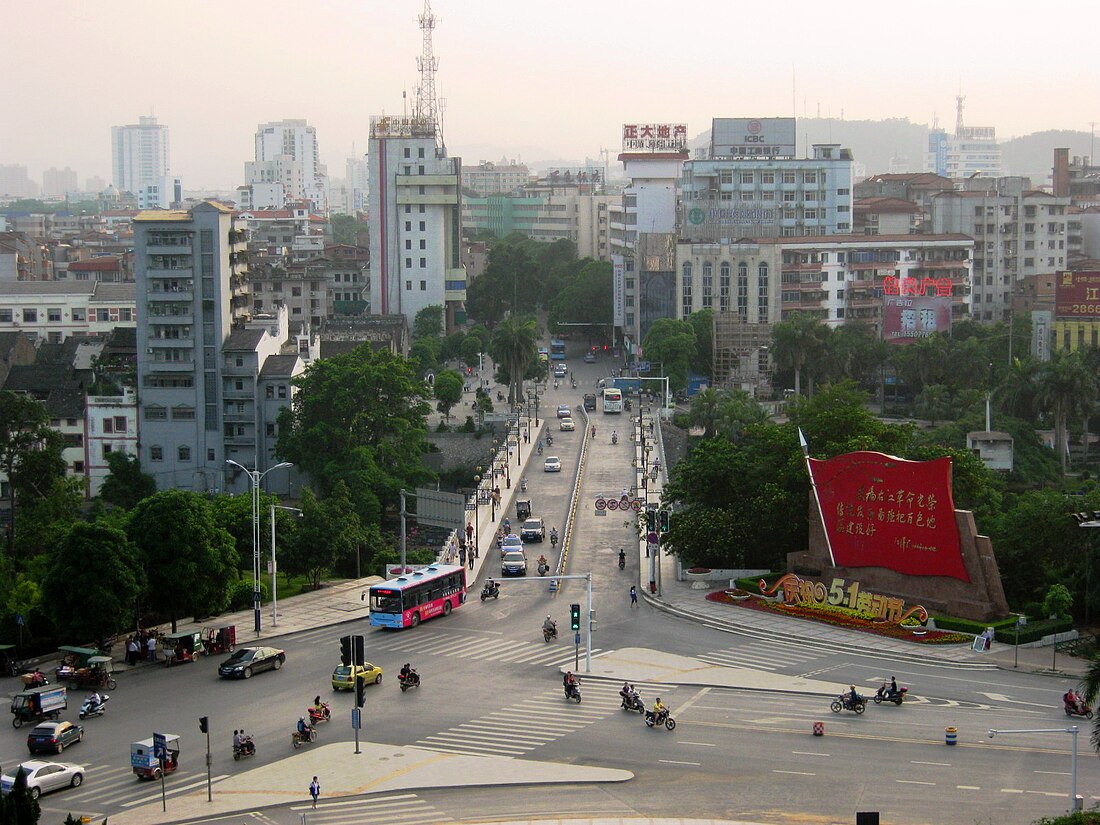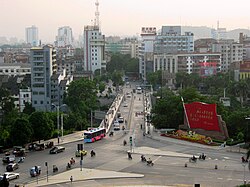Top Qs
Timeline
Chat
Perspective
Baise
Prefecture-level city in Guangxi, People's Republic of China From Wikipedia, the free encyclopedia
Remove ads
Baise (Chinese: 百色; pinyin: Bǎisè, Bósè; local pronunciation: paːk˧˥ ɬɐk˥), or Bose, is the westernmost prefecture-level city of Guangxi, China bordering Vietnam as well as the provinces of Guizhou and Yunnan. The city has a population of 4.3 million, of which 1.4 million live in the urban area.
The name is from Youjiang Zhuang Baksaek, meaning "in, or blocking, a mountain pass". The name Bwzswz is the Zhuang transliteration of the Chinese name.
Remove ads
Geography and climate
Summarize
Perspective

Baise is located in western-northwestern Guangxi bordering Qianxinan Buyei and Miao Autonomous Prefecture (Guizhou) to the north, Qujing and Wenshan Zhuang and Miao Autonomous Prefecture of Yunnan to the west, the Vietnamese provinces of Hà Giang and Cao Bằng to the south and southwest, and the Guangxi cities of Hechi to the northeast/east, Nanning to the east, and Chongzuo to the southeast. It is centrally located between three provincial capitals: Nanning, Kunming, and Guiyang. Its area is 36,252 km2 (13,997 sq mi) and is more than 55% forested.
Baise has a monsoon-influenced, humid subtropical climate (Köppen Cwa), with short, mild, and dry winters, and long, very hot and humid summers. The monthly 24-hour average temperature ranges from 13.5 °C (56.3 °F) in January to 28.4 °C (83.1 °F) in July, for an annual mean of 22.12 °C (71.8 °F). Rainfall is low compared to more easterly locations in Guangxi, averaging around 1,067 mm (42 in) per annum, a majority of which occurs from June to August. There are 1,706 hours of bright sunshine annually. Significant temperature variation exists in the prefecture; the western parts, with an average elevation surpassing 500 m (1,640 ft), lie along the southeastern fringes of the Yunnan–Guizhou Plateau, and hold a climate similar to that of central Yunnan, with much more moderate summer temperatures. With monthly percent possible sunshine ranging from 25% in January and February to 49% in August, the city receives 1,706 hours of bright sunshine annually.
Remove ads
History
The name of the city Baise is a Chinese transliteration of its original name in Youjiang Zhuang language, Baksaek, which probably means jammed gap (literally mouth(bak) blocked (saek)). Baise is young by Chinese standards and was founded as a town in 1730. It is the town where Deng Xiaoping, Chen Haoren and other leaders of the Chinese Communist Party organized the Baise Uprising against the Nationalist government on December 11, 1929. The uprising was also named Youjiang Rebellion.
Remove ads
Administration
Baise has 2 districts, 2 county-level city, 7 counties, and 1 autonomous county.
District:
- Youjiang District (右江区)
- Tianyang District (田阳区)
County-level city:
Counties:
- Tiandong County (田东县)
- Debao County (德保县)
- Lingyun County (凌云县)
- Napo County (那坡县)
- Leye County (乐业县)
- Xilin County (西林县)
- Tianlin County (田林县)
Autonomous County:
Demographics
Summarize
Perspective
Baise's population at the end of 2019 was 4,226,800, 1,383,400 of which live in the urban area.[9] 80% of the population belong to the Zhuang ethnic group. The rest include Han, Yao, Miao, Hui, and other ethnic groups.[10]
- These figures are based on the following official statistics:
Remove ads
Economy
Baise is one of China's most important producers of aluminum with both aluminum ore mining and aluminum product manufacturing. Baise's tropical climate make it a major food producer, especially fruits. Other natural resources include forest products, petroleum, natural gas, copper, and quartz. Baise is also Guangxi's third biggest producer of hydropower with 5 million kilowatts produced annually. Baise is also famous for mangoes.[12]
Remove ads
Tourism

Baise is blessed with beautiful natural scenery. Forested mountains harbor numerous species of plants and animals. The border areas are some of the least developed lands left in China. These features along with unique ethnic minority culture and important historical sites make it a growing tourist destination.[13]
Transportation
References
External links
Wikiwand - on
Seamless Wikipedia browsing. On steroids.
Remove ads




